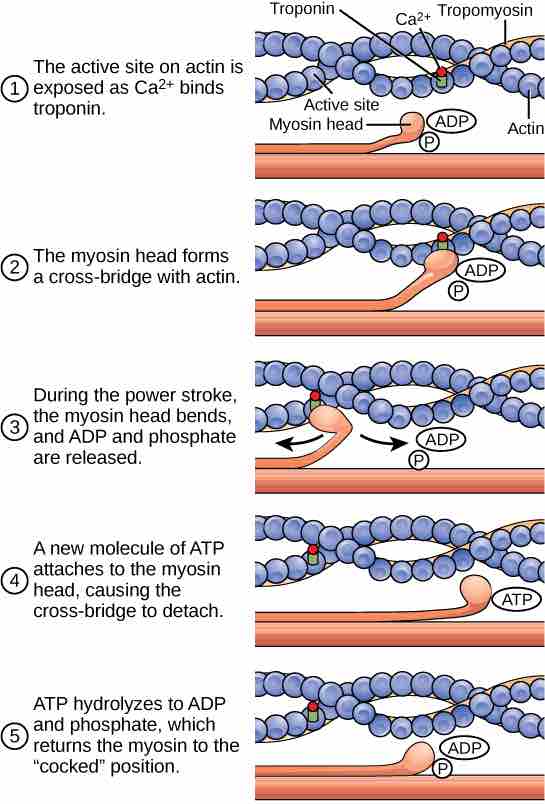ATP and Muscle Contraction
Muscles contract in a repeated pattern of binding and releasing between the two thin and thick strands of the sarcomere. ATP is critical to prepare myosin for binding and to "recharge" the myosin.
The Cross-Bridge Muscle Contraction Cycle
ATP first binds to myosin, moving it to a high-energy state. The ATP is hydrolyzed into ADP and inorganic phosphate (Pi) by the enzyme ATPase. The energy released during ATP hydrolysis changes the angle of the myosin head into a "cocked" position, ready to bind to actin if the sites are available. ADP and Pi remain attached; myosin is in its high energy configuration .

Cross-bridge muscle contraction cycle
The cross-bridge muscle contraction cycle, which is triggered by Ca2+ binding to the actin active site, is shown. With each contraction cycle, actin moves relative to myosin.
The muscle contraction cycle is triggered by calcium ions binding to the protein complex troponin, exposing the active-binding sites on the actin. As soon as the actin-binding sites are uncovered, the high-energy myosin head bridges the gap, forming a cross-bridge. Once myosin binds to the actin, the Pi is released, and the myosin undergoes a conformational change to a lower energy state. As myosin expends the energy, it moves through the "power stroke," pulling the actin filament toward the M-line. When the actin is pulled approximately 10 nm toward the M-line, the sarcomere shortens and the muscle contracts. At the end of the power stroke, the myosin is in a low-energy position.
After the power stroke, ADP is released, but the cross-bridge formed is still in place. ATP then binds to myosin, moving the myosin to its high-energy state, releasing the myosin head from the actin active site. ATP can then attach to myosin, which allows the cross-bridge cycle to start again; further muscle contraction can occur. Therefore, without ATP, muscles would remain in their contracted state, rather than their relaxed state.